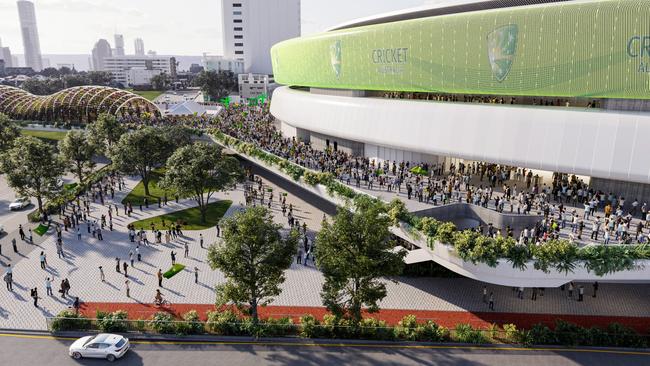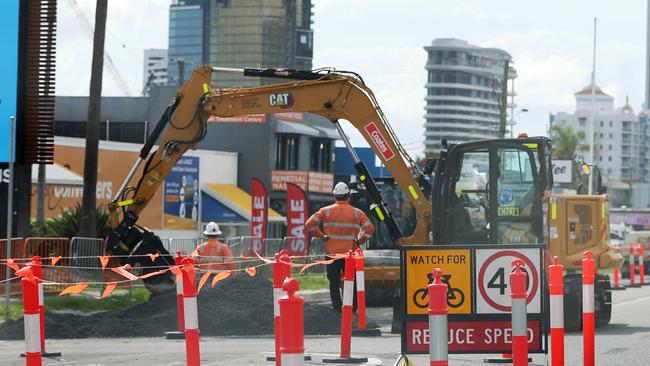Major project cost blowouts to cost Queenslanders billions
Major Olympic, energy and infrastructure projects are facing blowouts that could cost Queensland billions, with construction inflation forecast to increase by 4 per cent.
QLD Politics
Don't miss out on the headlines from QLD Politics. Followed categories will be added to My News.
Major Olympic, energy and infrastructure projects are facing blowouts that could cost Queensland billions, with construction inflation forecast to increase by 4 per cent per year from 2028, Oxford Economics Australia has warned.
Economists are urging policymakers to implement stronger productivity measurers and better project planning to avoid major blowouts towards the end of the decade, with projects worth $1bn or more predicted to blowout by an average of $200m each.
Queensland projects at risk of being affected by cost inflation include Copper string 2.0, all Olympic infrastructure, the Gabba redevelopment, Gold Coast light rail and the Burdekin pumped hydro project.

Oxford Economics Australia senior economist Adrian Hart warned Queensland would be hit hardest by the inflation forecast due to its mammoth infrastructure pipeline and Olympic and Paralympic works slated to start around 2028.
“The demand side pressures we are talking about in our report are probably going to impact Queensland more than any other state,” he said.
“That can be quite significant when you’re dealing with large kinds of expenditures over a long period of time too because pumped hydro, for instance, is a long period of time … the longer the project takes, the more it is a risk of escalation during that period.
“It is also a warning for Olympics infrastructure to just make sure that they’ve got the costings right.”
Spending for Queensland’s Big Build program up to mid-2028 has already ballooned from $89bn to $107bn.
While construction costs escalated at record rates of 5.7 per cent in 2022 and 8.2 per cent in 2023, these surges were driven by supply and demand shocks in domestic and overseas markets.

Those inflation factors are now predicted to be overtaken by new domestic inflation drivers including wage growth, high demand of housing and infrastructure and the adoption of sustainable building practices alongside poor productivity levels.
Mr Hart said the next four years were critical to get productivity under control.
“Wage increases themselves aren’t the issue, it’s wage increases without seeing any productivity,” he said. “If we could target some sort of stronger growth in productivity, have the metrics in place that could better measure that productivity, because at the moment, it is a little bit of a black box … we’d be able to better manage the costs of delivering infrastructure and the demands on labour and materials.”
He said governments needed to ensure productivity rates and workforce strength were properly accounted for when setting infrastructure targets.
“There is definitely a case for doing as much planning work as possible, making sure that you’re eliminating risks on these projects, and just trying to co-ordinate infrastructure so that you’re not overly testing the market’s capacity to deliver and at the same time,” he said.
“Better work could be done in planning to make sure that we don’t have a wave of projects in any particular sector.”

AT-RISK PROJECTS SLATED TO GO BEYOND 2027
Gold Coast Light Rail stage 4 Tugun to Coolangatta – $2.7bn
Varsity Lakes to Tugun rail widening – $1bn
Coomera Hospital – $1.3bn
Coomera connector – $5bn
Gabba stadium redevelopment – $5.2bn –
Roma St Station precinct – $3bn
Brisbane Olympic and Paralympics Arena – $2.7bn
Brisbane Olympic and Paralympics athletes village – $1.4bn
Redcliffe Hospital expansion – $1.1bn
Brisbane Airport Masterplan – $3.8bn
Caloundra South Masterplan – $5bn
Sunshine Coast light rail – $2bn
Beerwah-Caloundra heavy rail – $5.5bn
Beerburrum-Nambour heavy rail – $1bn
Borumba pumped hyrdo – $14.2bn
Paradise Dam project – $1.1bn
Central Queensland hydrogen project – $14.8bn
Urannah Dam water scheme – $2.9bn
Port Carpentaria railway -$1.5bn
Copper string 2.0 – $5bn
Daisy Hill to Logan Mwy – $1bn
Gateway Mwy Brisbane-Moreton upgrade – $2.1bn
Burdekin pumped hyrdo – $12bn
Galilee Infrastructure Corridor – $10bn
Toowoomba Hospital – $1.3bn
Rockhampton Ring Road – $1.7bn
Imperial Square – $2.3bn
Inland Rail Helidon to Calvert – $1.4bn
Inland Rail- Border to Gowrie – $1.4bn
Waterfront Place Eagle Street – $2.5bn
Queensland Housing Investment Growth Initiative – $1.9bn
Maroochydore City Centre – $2.5bn
Eagle Farm and Doomben Racecourse Redevelopment – $1.5bn


